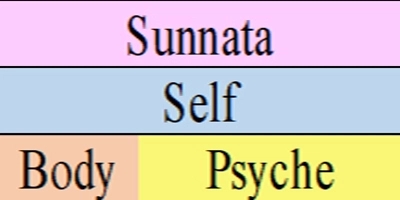|
|
 The path of compassion, insight and creativity - the struggle for GAIA and against the 1%-satrapy of war and wage-slavery.
The path of compassion, insight and creativity - the struggle for GAIA and against the 1%-satrapy of war and wage-slavery. |
| |
| This is a continuation of my zandtao blog. |
|
Email Zandtao:- |
|
|
|
 Zandtao Blog Links page Zandtao Blog Links page |
|
Meditation, Sunnata and Gaia-consciousness How does meditation work? I have no real idea. Does it work? Definitely. How do I know it works? Because it affects me in daily life, for me the measure of meditation is whether it works in daily life. What does it do to me in daily life? I don’t have a clear answer to this either. I notice that if my meditation isn’t good I get irritated with little things like the wind opening and closing my bedroom door – with the lock I can’t fix!! It matters not what the irritation is, there is irritation when meditation is not good; when meditation is good the wind blows the door but there is no irritation. There is no logic to meditation either. What does it mean “meditation is not good”? To me that has nothing to do with the daily meditation session. Sometimes the 45 minutes is long – dragging on, looking to see how long left, and other times the alarm just goes soon after I have sat. Even though there might be a feeling of dragging during the meditation, I have noticed no correlating pattern in daily life. If I miss several days I notice it, if I miss one day I don’t. What is my meditation object? At one time it was the breath but now I don’t have one. I started trying to meditate daily nearly 20 years ago. In the winter of 2000 I went on holiday to Thailand (I was working in Oman at the time). I sat in Wat Phra Keau (the temple of the Emerald Buddha). It is a place of venerational visits for Thai people and a place for visiting tourists so it did not have a feeling of meditational peace. But I sat on the floor in discomfort – I don’t sit well on floors, and after a long while I felt a revelation that I was a Buddhist – focussed on the Emerald Buddha statue. To me being a Buddhist meant that I should study Buddhism - Buddhist texts, and being Wat Phra Keau they were mainly Theravadan texts – at least I started that way. But being Buddhist also meant to me that I should meditate. From that time on I meditated. My ideal would be twice a day like I did at Harnham retreats, but I have rarely been able to meditate of an evening. It’s kind of like the mind sorts itself out during the night, and when I wake up I want to finish the job. By the time evening comes the khandhas especially sankhara are so active, it is just discipline to calm them down. I have never felt the benefit from such evening discipline although I have tried it especially when I went through a Shikantaza phase. There was one time I didn’t meditate – when I was in Nigeria. That was such an awful situation, every time I meditated my guide told me I should leave. Instead I resolved to stay ashamedly for the money – the salary was not that good but I saved ?1000 a month because of my cost of living (no rent, free car, and veg), at the end of the awful two-year contract I realised I could retire – something I had never considered at the start. So the guide was working well in my not meditating What I meditate on depends on the guide and has changed so much in nearly 20 years that I could only guess from blogs what the guide was doing. For me the guide is not a faculty of mind it is a process, and the process is integrated between clarity and what I am studying and creating. The guide decides on what I study and the study fashions the guiding process, and sometimes creativity leads the way as it did with Gaia. There is not a faculty of mind like intellect that comes into play and decides. At times I have sat down to meditate and asked the guide what I should be studying, and other times coincidence provides the study. Through the various stuff that comes to my attention on my computer the guide suddenly recognises (coincidence) that is where I should be going. Sometimes the guide directs me to writing – a storyline maybe. Once aware of it anatta has been a constant thing in meditation. Perhaps this is why I liked Thandie Newton’s TED talk so much, she grew up living anatta as her path – that is fascinating. I will never forget the glimpse of the love of sharing the path at the end, but I have to be realistic some/much of that impact on me must have been because of her amazing beauty and my attraction to her. With ego there is a need for detachment, with self there is a need for detachment. So in meditation there is always a need for detachment, and detachment is now part of every practice. For a while now my meditation practice could have been seen through the lens of this meme:-  So detach from the 5 khandhas (body and psyche), detach from self, and let sunnata flow in. I kind of visualise this. Once I am sat and calm, then I let go of attachments. I see them as kind of amorphous gunky entities that have attached to the core of me especially inside my head, and I just let them fall down and out. This goes on releasing a sense of heaviness. And when this heaviness has gone I breathe in sunnata to fill up the emptiness left by the heaviness. All of this goes on whilst I get insights about what my next blog should be – as the clarity comes with the heavy entities disappearing, or whilst sankhara is developing a previous insight – from meditation or not. So I am comfortable calling my meditation – insight meditation or vipassana. More recently meditation has changed. Instead of visualising breathing in sunnata I visualise breathing in Gaia-consciousness, and this difference is very significant, the significance being the point of this blogpost – what I have written so far is meditational context. Where did this come from? Gaia becoming more integral started with the final chapter of the Treatise. But Gaia really became more significant when I began writing about being dispossessed in Ch6 of the Pathtivism manual. Soon after recognising this dispossession I began breathing in Gaia-consciousness. It was also mixed in with Tai Chi and Chi Gung techniques. Tai Chi talks of the body as a ridgepole, and building chi primarily in the Tan Tien but also in the ridgepole. There is a Chi Gung technique of connecting heaven and earth, and this brings chi from deep in the earth up through the ridgepole of the body and out through the top of the head into heaven. In meditation I visualise Gaia-consciousness coming up from deep in the earth, entering the ridgepole filling any gaps, and out through the top of my head. By this visualisation I become Gaia-consciousness. Note this is a visualisation. I have never been sunnata, I am never Gaia-consciousness. Now sunnata and Gaia-consciousness are no different, from a theoretical point of view sunnata is just Gaia-consciousness. Yet this change of emphasis in meditation is impacting greatly on me in daily life. Let me be clear Gaia-consciousness and sunnata are no different, they are words that describe the same thing. But remember any form of word-conceptualisation diminishes the reality of sunnata, the reality of Gaia-consciousness. So if we were ever able to properly describe the Unity that is sunnata, that is Gaia-consciousness, they would be the same. Yet I observe a big difference from the diminished position in my daily life, I have become far more conscious of environmental issues. Yes my awareness was changing in my writing as described above, but the change is also happening because of meditation. For me this change has great spiritual significance. For spiritual people in the non-indigenous western world meditation is the means of connecting to spirit – to awareness. It is usual to meditate on the more “nebulous” spirit, such as sunnata. In the 4NT we meditate on suffering, the existence of suffering being the first truth, but then we focus on the personal by recognising that clinging to desire is what causes personal suffering. All of this is personally beneficial, and developing peace by the removal of suffering is important for all. But what about the suffering that is caused by our contributions as spiritual people to the political system? Changes in our humanity through spiritual awareness are beneficial to all but we are still consuming as human beings. How much does that consuming change? Does it change enough? How much do our actions help change the political system that adds to human suffering? When we look at suffering from the purely personal ie ending the clinging to desire we are missing so much suffering. There can be a lack of engagement. When we consider sunnata which in our daily life we might interpret as a more “spiritual” aspect of Gaia-consciousness, perhaps we are less conscious that we do not drive EV, that there are Buddhist countries which do not have an EV infrastructure, that we do not have solar panels, that we still consume too much plastic including single-use plastic. These are all issues of Gaia-consciousness in the same way they are issues of sunnata, of spirit, but for me when I was breathing in sunnata in my daily life I was not as conscious (still conscious though) of consumer environmental issues. I MUST ask myself about this. But this is not a MUST of pc-authoritarianism for others. Don’t beat yourself up. Being aware is being aware, it is your path and you cope with daily life how you can. There is enough suffering going around I don’t want to add by demanding that you beat yourself up because of the environment, political system or whatever. But sometimes because being spiritual – following the path - makes us feel so much better we can become complacent and avoid some issues. And avoidance is a spiritual weakness. But remember “it is up to you”, I want no more pressure than that. Maybe this is an issue for monks. Monks I completely accept that you are the Guardians of the teaching – you are the spiritual teachers. Monks your lives are in cloisters, the people you meet always treat you with respect because of the teaching; is there a cocoon? Should you be teaching spirit and sunnata or Gaia-consciousness? When you talk of suffering do you talk of the suffering inherent in the political system or just the suffering that comes from paticca-samuppada? More importantly, monks, does your institution ask these questions? I am asking that you ask more of these questions of yourselves and your teaching practice because Gaia is being destroyed.
| |||
| Books:- Treatise, Pathtivism Manual, Wai Zandtao Scifi, Matriellez Education. Blogs:- Matriellez, Mandtao. |